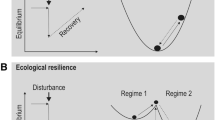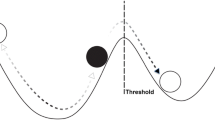Abstract
We consider the putative tradeoff between optimization and resilience in the management of natural resources, using a framework that incorporates different sources of uncertainty that are common in natural resources management. We address one-time decisions, and then expand the decision context to the more complex problem of iterative decision making. For both cases we focus on two key sources of uncertainty: partial observability of system state and uncertainty as to system dynamics. Optimal management strategies will vary considerably depending on the timeframe being considered and the amount and quality of information that is available to characterize system features and project the consequences of potential decisions. But in all cases an optimal decision making framework, if properly identified and focused, can be useful in recognizing sound decisions. We argue that under the conditions of deep uncertainty that characterize many resource systems, an optimal decision process that focuses on robustness does not automatically induce a loss of resilience.
Access this chapter
Tax calculation will be finalised at checkout
Purchases are for personal use only
Similar content being viewed by others
References
Bellman, R. (1957). Dynamic programming. Princeton: Princeton University Press.
Bellman, R., & Dreyfus, S. (1962). Applied dynamic programming. Princeton: Princeton University Press.
Ben-Haim, Y. (2006). Info-gap decision theory: Decisions under severe uncertainty (2nd ed.). London: Academic Press.
Bertsekas, D. P. (2007). Dynamic programming and optimal control (Vols. 1 and 2, 3rd ed.). Belmont: Athena Scientific.
Burgman, M. (2005). Risks and decisions for conservation and environmental management. Cambridge: Cambridge University Press.
Carpenter, S. R., Brock, W. A., & Ludwig, D. (2002). Collapse, learning and renewal. In L. H. Gunderson & C. S. Holling (Eds.), Panarchy: understanding transformations in human and natural systems. Washington, D.C.: Island Press.
Fischer, J., Peterson, G. D., Gardner, T. A., Gordon, L. J., Fazey, I., Elmqvist, T., Felton, A., Folke, C., & Dovers, S. (2009). Integrating resilience thinking and optimization for conservation. Trends in Ecology and Evolution, 24, 549–554.
Gregory, R. S., & Keeney, R. L. (2002). Making smarter environmental decisions. Journal of the American Water Resources Association, 38, 1601–1612.
Holling, C. S., & Meffe, G. K. (1996). Command and control and the pathology of natural resource management. Conservation Biology, 10, 328–337.
Hull, D. (2003). Optimal control theory for applications. New York: Springer-Verlag.
Kaelbling, L. P., Littman, M. L., & Cassandra, A. R. (1998). Planning and acting in partially observable stochastic domains. Artificial Intelligence, 101, 99–134.
Kangas, A., Kangas, J., & Kurttila, M. (2010). Decision support for forest management. New York: Springer.
Lempert, R. J., & Collins, M. T. (2007). Managing the risk of uncertain threshold response: Comparison of robust, optimum, and precautionary approaches. Risk Analysis, 27, 1009–1026.
McCarthy, M. A. (2007). Bayesian methods for ecology. Cambridge: Cambridge University Press.
Peterson, G. D., Carpenter, S. R., & Brock, W. A. (2003). Uncertainty and the management of multistate systems: An apparently rational route to collapse. Ecology, 84, 1403–1411.
Polasky, S., Carpenter, S. R., Folke, C., & Keeler, B. (2011). Decision-making under great uncertainty: Environmental management in an era of global change. Trends in Ecology and Evolution, 26, 398–404.
Regan, H. M., Ben-Haim, Y., Langford, B., Wilson, W. G., Lunberg, P., Andleman, S. J., & Burgman, M. A. (2005). Robust decision making under sever uncertainty for conservation management. Ecological Applications, 15, 1471–1477.
Runge, M. C. (2011). An introduction to adaptive management for threatened and endangered species. Journal of Fish and Wildlife Management, 2, 220–233.
Shenk, T., & Franklin, A. (Eds.). (2001). Modeling in natural resource management: Development, interpretation, and application. Washington, D.C.: Island Press.
Simonovic, S. P. (2009). Managing water resources: Methods and tools for a systems approach. Paris: UNESCO Publishing.
Sniedovich, M. (2011). Dynamic programming: Foundations and principles (2nd ed.) Boca Raton: CRC Press.
Stengel, R. F. 1994. Optimal control and estimation. New York: Dover Publications Inc.
Walker, B., & Salt, D. (2006). Resilience thinking: Sustaining ecosystems and people in a changing world. Washington, D.C.: Island Press.
Walker, B., Holling, C. S., Carpenter, S. R., & Kinzig, A. (2004). Resilience, adaptability and transformability in social-ecological systems. Ecology and Society, 9(2):5. http://www.ecologyandsociety.org/vol9/iss2/art5.
Walters, C. J. (1986). Adaptive management of renewable resources. New York: McGraw Hill.
Williams, B. K. (2001). Uncertainty, learning, and optimization in wildlife management. Environmental and Ecological Statistics, 8, 269–288.
Williams, B. K. (2009). Markov decision processes in natural resources management: Observability and uncertainty. Ecological Modelling, 220, 830–840.
Williams, B. K. (2011a). Adaptive resource management and the value of information. Ecological Modelling, 222, 3429–3436.
Williams, B. K. (2011b). Resolving structural uncertainty in natural resources management using POMDP approaches. Ecological Modelling, 222, 1092–1102.
Williams, B. K., Nichols, J. D., & Conroy, M. J. (2002). Analysis and management of animal populations. San Diego: Academic Press.
Author information
Authors and Affiliations
Corresponding author
Editor information
Editors and Affiliations
Rights and permissions
Copyright information
© 2015 Springer Science+Business Media Dordrecht (outside the USA)
About this chapter
Cite this chapter
Williams, B., Johnson, F. (2015). Optimization and Resilience in Natural Resources Management. In: Allen, C., Garmestani, A. (eds) Adaptive Management of Social-Ecological Systems. Springer, Dordrecht. https://doi.org/10.1007/978-94-017-9682-8_12
Download citation
DOI: https://doi.org/10.1007/978-94-017-9682-8_12
Published:
Publisher Name: Springer, Dordrecht
Print ISBN: 978-94-017-9681-1
Online ISBN: 978-94-017-9682-8
eBook Packages: Earth and Environmental ScienceEarth and Environmental Science (R0)




